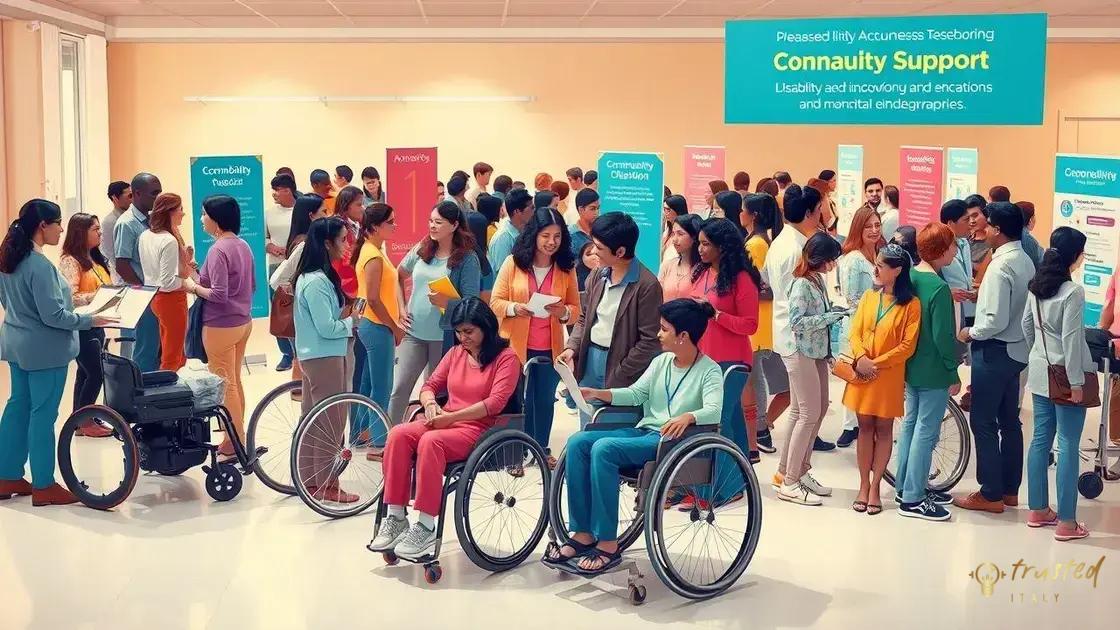The future of disability benefits in a post-pandemic world

The future of disability benefits is shaped by new eligibility criteria, improved access through technology, and the need to address funding challenges and demographic changes, ensuring comprehensive support for all individuals with disabilities.
The future of disability benefits in a post-pandemic world looks different than it did before. As society adapts to new realities, understanding these changes is crucial for those affected.
Understanding the impact of the pandemic on disability benefits
The pandemic has significantly changed how we view and implement disability benefits. Many individuals found themselves relying more heavily on these essential supports during this difficult time. As we navigate this new reality, it’s crucial to understand how these benefits were impacted.
Changes in Application Processes
Applying for disability benefits has evolved. Many agencies moved to online platforms, making it easier for applicants to submit their claims. This shift meant more accessibility for those unable to visit offices. However, it also led to a backlog of applications.
Effects on Eligibility Criteria
Many programs adjusted their eligibility criteria to accommodate the challenges posed by the pandemic. For instance:
- Temporary expanded access for applicants affected by COVID-19.
- Increased consideration for mental health issues, which have surged during this time.
- Streamlined processes for disability evaluations, focusing on remote assessments.
These adjustments aimed to provide timely support for those most in need. Moreover, they highlighted the importance of efficient systems in responding to crises.
Funding Challenges
Even though disability benefits are crucial, they faced funding challenges during the pandemic. Many government budgets were stretched thin due to health-related expenditures. This situation raised concerns about the sustainability of existing programs moving forward.
As we continue to adapt, it’s important to monitor how disability benefits evolve. Stakeholders must advocate for continued support and improvements in access. Keeping the conversation alive about these vital services can help ensure that nobody falls through the cracks in times of need.
Trends shaping disability support in 2023

As we move into 2023, several trends are shaping the way we provide support to individuals with disabilities. Understanding these trends is essential for optimizing support systems and ensuring that they meet the diverse needs of the community.
Increased Focus on Mental Health
There is a growing recognition of the importance of mental health as a crucial aspect of disability support. Many programs now emphasize mental health services, which were often overlooked in the past. This shift helps address the emotional and psychological challenges that individuals with disabilities face.
Technological Integration
Technology is playing a significant role in transforming disability benefits. From telehealth services to mobile apps, technology facilitates access to support. These innovations can make it easier for individuals to connect with healthcare providers and manage their daily needs.
Moreover, technology helps streamline the application process for benefits. Many agencies are utilizing online portals, which provide a faster way to submit claims and access resources. This change ensures that recipients can receive assistance more efficiently, reducing waiting times significantly.
Community-Based Approaches
In 2023, there is a notable move towards community-based support systems. This approach emphasizes inclusive practices within local communities, allowing individuals to receive support where they live. Community-based services foster connections and help build social networks, which are vital for emotional well-being.
- Collaboration with local organizations to enhance service delivery.
- Promotion of social inclusion initiatives.
- Development of peer support networks to empower individuals.
This trend reflects a broader understanding that support systems work best when they are integrated into the community fabric, allowing for personalized and culturally relevant resources.
As these trends continue to evolve, it’s essential for stakeholders to stay informed and engaged. Keeping abreast of the latest developments can help ensure that support systems remain effective and responsive to the needs of individuals with disabilities.
New eligibility criteria for disability benefits
Recent changes have led to new eligibility criteria for disability benefits that aim to be more inclusive. These adjustments are essential as they reflect the evolving needs of individuals with disabilities.
Expanded Criteria
The new criteria include expanded definitions of disability to encompass a broader range of conditions. This means that individuals who may not have qualified before can now receive the support they need. Some examples of conditions that now receive greater consideration include:
- Chronic mental health issues.
- Neurodevelopmental disorders.
- Long-term effects from COVID-19.
Understanding these changes is crucial for individuals and families seeking support. With a wider range of qualifying conditions, more people can access necessary resources.
Streamlined Application Processes
The application process has also been simplified to make it easier for applicants to navigate. This includes:
- A more user-friendly online submission system.
- Clearer guidelines on required documentation.
- Support services available to assist applicants.
These improvements aim to reduce barriers and ensure that individuals can smoothly apply for the benefits they need.
Moreover, there is a focus on ensuring that the application process considers the unique challenges faced by applicants. For example, accessibility features are being integrated into online portals to cater to those with different abilities.
The new eligibility criteria not only help more individuals qualify for support but also emphasize understanding community needs. Learning about these changes can empower those who may have previously struggled with the system.
Technological advancements in disability services

Technological advancements are transforming disability services and making support more accessible. Innovations in technology are changing how individuals with disabilities receive assistance and resources.
Telehealth Services
One of the most significant changes is the rise of telehealth services. This approach allows individuals to connect with healthcare professionals from the comfort of their homes. Telehealth has made it easier for many to access essential care without the challenges of transportation.
Assistive Technology
New assistive technologies are also improving everyday life. This includes:
- Smart home devices that aid in independence.
- Speech recognition software for those with mobility challenges.
- Mobile apps designed to provide support and resources.
These tools enable individuals to perform daily tasks more efficiently and improve their overall quality of life. By integrating technology into disability support, individuals can gain more control over their situations.
Data Management Systems
Moreover, advancements in data management systems enhance the efficiency of service delivery. Social service agencies are using data analytics to better understand the needs of the community. This knowledge helps them tailor their services more effectively and ensures that individuals receive the right assistance promptly.
Through improved data sharing and communication, disability services can respond quickly to changes and challenges faced by individuals, ultimately promoting greater support.
It’s clear that technology is reshaping the landscape of disability services. As more innovations emerge, they offer exciting opportunities to enhance support systems and empower individuals with disabilities in their daily lives.
Future challenges in disability benefits
The future of disability benefits presents several challenges that stakeholders must address. Understanding these challenges is critical to ensuring effective support for individuals with disabilities.
Funding Limitations
A significant challenge is the ongoing funding limitations faced by many disability programs. As more individuals qualify for benefits, there is increased pressure on government resources. This situation can lead to reduced funding per individual, making it harder for programs to provide comprehensive support.
Access to Services
Accessing disability benefits remains a hurdle for many. Barriers include:
- Complex application processes that may deter potential recipients.
- A lack of awareness about available benefits in underserved communities.
- Geographical barriers that limit access to important resources.
Improving access is vital to ensure that everyone who qualifies can take advantage of the support offered. Addressing these hurdles requires outreach and educational initiatives that inform communities about their rights and the resources available to them.
Changing Demographics
The demographics of individuals seeking support are also shifting. As the population ages, more seniors are becoming eligible for disability benefits. This trend demands that programs adapt to meet the unique needs of older adults. Developing age-appropriate support services can help in managing chronic conditions that are common in older populations.
Furthermore, there’s a growing recognition of the challenges faced by individuals with invisible disabilities. This realization calls for enhancements in how benefits are assessed and distributed.
Ultimately, as we look to the future, it’s crucial for policymakers to remain responsive to the evolving landscape of disability benefits. Proactive measures can help ensure that all individuals receive the support they deserve.
FAQ – Frequently Asked Questions about Disability Benefits in a Post-Pandemic World
What are the new eligibility criteria for disability benefits?
The new eligibility criteria have expanded to include more conditions, such as chronic mental health issues and long-term effects from COVID-19.
How has technology improved access to disability services?
Technology has streamlined application processes through telehealth services and user-friendly online platforms, making it easier for individuals to apply for benefits.
What challenges do seniors face regarding disability benefits?
Seniors often require tailored support due to aging-related conditions, making it essential for programs to adapt to their specific needs.
How can communities promote awareness about disability benefits?
Communities can organize educational outreach programs to inform individuals about available benefits and the application process.